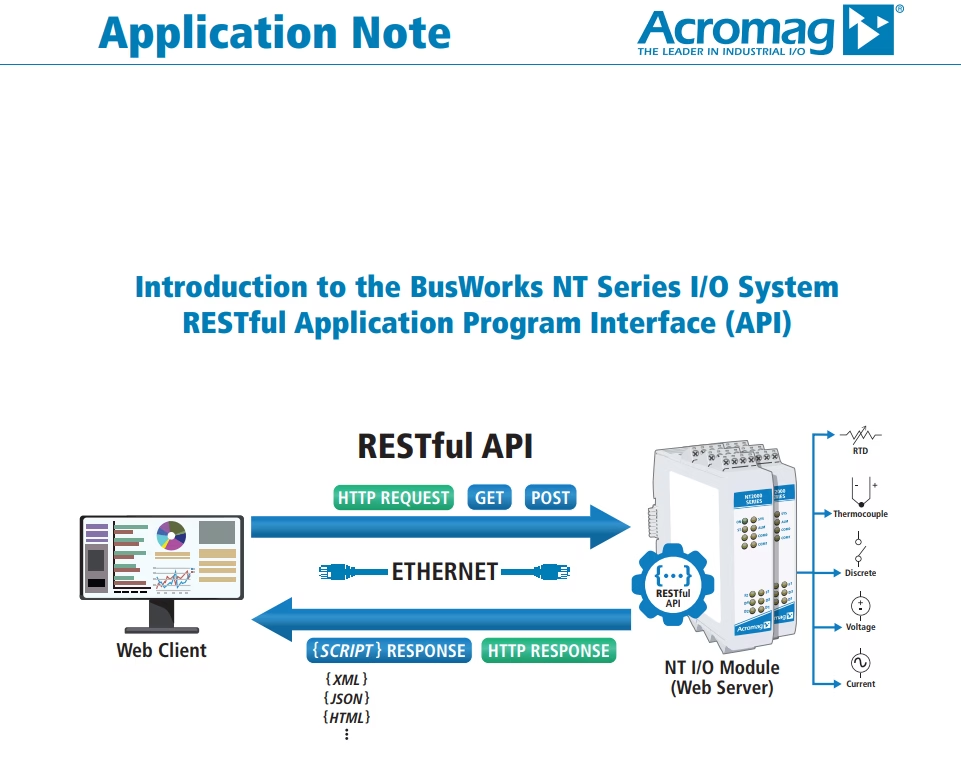Simplify Industrial I/O Integration with Acromag’s BusWorks® NT Series RESTful API
As industrial automation evolves, engineers and integrators are constantly seeking easier ways to interface remote I/O devices with modern applications. Acromag’s BusWorks® NT Series delivers a simple yet powerful solution. With a built-in RESTful API that enables seamless control and monitoring of I/O over Ethernet—without extra software or middleware.
Whether you’re integrating with SCADA, designing a custom dashboard, or developing an IoT application. The NT Series RESTful API allows I/O control over Ethernet and helps you connect quickly and reliably.
What is the BusWorks® NT Series?
Acromag’s NT Series is a modular I/O system that offers:
- Support for up to 4 I/O modules per system
- 18 different module types, including:
- Discrete I/O
- Voltage/Current inputs and outputs
- Thermocouple and RTD sensors
- AC voltage/current inputs
- Analog I/O
- Options for wired (NTE) and wireless (NTW) Ethernet communication
- Expandable architecture using NTX modules over a DIN rail bus
With this flexibility, NT systems can be configured for up to 48 I/O channels under a single IP address.
Why Use a RESTful API?
A RESTful API (Representational State Transfer) uses standard HTTP methods (GET, POST) for client-server communication. This means you can send simple requests to the NT system to read sensor values or control outputs—just like visiting a webpage.
Benefits include:
- No proprietary software
- Language-agnostic integration (use Python, JavaScript, C#, etc.)
- Simple command structure
- Secure session-based communication
Getting Started: Interacting with the NT RESTful API
You can begin using the API with tools like cURL or Postman. Here’s a quick guide using cURL:
1. Authenticate and Start a Session
curl -X POST -d "username=admin" -d "password=password" http://<IP_ADDRESS>/webif/login
You’ll receive a sessionID—this must be included in all future requests.
2. Get Slot Information
Check what modules are installed:
curl -X GET http://<IP_ADDRESS>/webif/slots_sessionID=<sessionID>
Want details about Slot 1?
curl -X GET http://<IP_ADDRESS>/webif/slots/1_sessionID=<sessionID>
3. Read Channel Data
Read an analog input value from Slot 2, Channel 1:
curl -X GET http://<IP_ADDRESS>/webif/slots/2/analog-input/1_sessionID=<sessionID>
4. Write to Output Channels
Turn on a digital output:
curl -X POST -d "newValue=1" http://<IP_ADDRESS>/webif/slots/2/digital-input-output/1_sessionID=<sessionID>
Set an analog output to 4.5V:
curl -X POST -d "newValue=4.5" http://<IP_ADDRESS>/webif/slots/2/analog-output/1_sessionID=<sessionID>
Best Practices to Avoid Errors
- Always include a valid session ID
- Use GET to retrieve data and POST to modify it
- Confirm channel type and slot compatibility
- Double-check for typos or invalid characters in your URLs
Final Thoughts
The BusWorks® NT Series RESTful API allows I/O control over Ethernet. Offering a fast, flexible, and future-ready way to integrate industrial I/O into your Ethernet-based systems. Its lightweight, standards-based architecture is perfect for developers, system integrators, and OEMs building modern automation solutions.
Need help selecting the right modules or getting started with your first command? Contact us today—we’re here to help. Or to read the original application guide.
/
